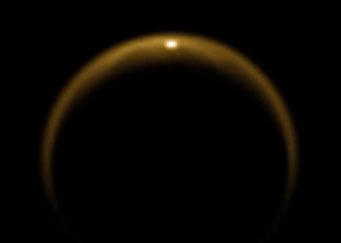Among the trove of discoveries being amassed by NASA's Cassini orbiter are a few that stand head and shoulders above the rest. One of those is the realization that Titan, Saturn's big moon, has lakes of liquid hydrocarbons on its surface.
A couple of years ago, I would have written that as "probably has lakes," because the circumstantial evidence for them was strong &mdash: but not ironclad. The spacecraft had returned images showing large, dark, irregularly shaped blobs in its polar regions, some of which changed shape since Cassini's arrival in 2004. The case got much stronger when radar scans revealed that these enclosures had very smooth surfaces, and an infrared spectrometer found liquid ethane (C2H6) within one of them.

Sunlight dances off on of the hydrocarbon lakes dotting the north polar region of Titan. Cassini's visual and infrared mapping spectrometer (VIMS) recorded this infrared view on July 28, 2009.
NASA / JPL / Univ. of Arizona / DLR
Now the Cassini team has found the smoking gun they've been seeking. The image here shows a glint of sunlight reflecting off one of the moon's northern lakes, a region that's been in darkness during the mission until Saturn recently passed through equinox and spring returned to the northern hemisphere. Cassini's visual and infrared mapping spectrometer (VIMS) recorded it at infrared wavelengths near 5 microns, at which Titan's dense, hazy atmosphere appears relatively transparent. VIMS took the image back on July 8th, but it wasn't made public until late last week.
Hints of specular reflection off of liquids on Titan's surface had been seen in 2003, using radar pulses from the giant radio dish at Arecibo, Puerto Rico. But that effort probed a region near 26° south, and there was no way to pinpoint a specific feature associated with it.
Not so with Cassini's sunglint. After careful checking, team scientists traced this specular reflection to the southern shoreline of a lake called Kraken Mare at 71° north, 337° west. One of the moon's biggest pools, Kraken Mare covers about 150,000 square miles, an area larger than the Caspian Sea on Earth.
Apart from its scientific importance, I just find this image visually stunning. I hope you do too.
 2
2
Comments
David Roberts
December 25, 2009 at 5:21 pm
This shows once again the value of robotic exploration of the solar system. With missions such as this and KEPLER, NASA and its partners are leading the search for life elsewhere in the Universe, arguably humanity's greatest quest.
You must be logged in to post a comment.
Ken Durham
December 28, 2009 at 6:33 am
makes one wonder if earth-bound hydrocarbons have origins other than dead plant & animal life...
You must be logged in to post a comment.
You must be logged in to post a comment.